5 Minutes a Day For a Flat Stomach
Spend 5 minutes getting out of bed doing the exercises suggested below. Your stomach will become flat!
Discover the firming core and postural super training
Millions of North Americans practice the sit-up to no avail. It is no wonder. The fact that you can do dozens of them in a row shows that these exercises have little effect on the desperately flabby muscles of the abdominal strap . So what is working? That’s what researchers at California State University set out to find out. After giving 18 men and women electrodes sensitive to muscle activity, they asked them to do sit-ups and other abdominal exercises. None resisted analysis.
The movements that have given the best results are the ones we are proposing here. It is a two-part program, which takes only 5 minutes a day. The first component (or firming sheathing) aims to strengthen the muscles of the abdominal strap, the second (postural super training), to tone the back muscles, which improves your posture and lengthens your figure, giving you a more belly. dish.
Many of these exercises require an exercise ball (or Swiss ball) – found in most department stores and sports equipment stores. Consult the table on the packaging for the appropriate diameter, which is based on the size. Repeat each exercise 8-10 times without interruption, and perform your movements slowly. Do the core strengthening exercises every other day, three times a week, the other two days being devoted to postural super-training: a total of 25 minutes per week.2 /10
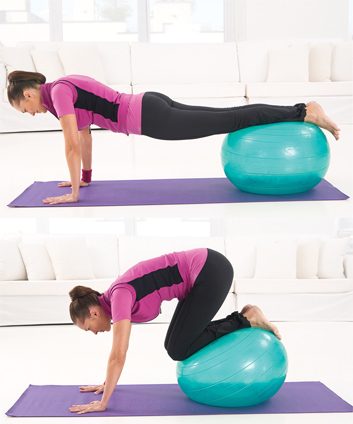
Jack knife
Target : abs, back, chest, shoulders, hips.
Why it works : The abs must perform two simultaneous contractions: the isometric (or static), which provides stability on the ball, and the active, which occurs when the knees are brought back to the chest.
1. Lie down on the ball with your face down and your hands resting on the floor. Move your hands as if you were walking, so that the ball rolls to bring it under your shins. Your hands should be directly under your shoulders as if you are about to do a push-up, and your body should form a straight line.
2. Contract your abs and bend your knees, bringing them towards you so that your legs and the ball are closer to your torso. Hold the position for a second. Straighten your legs and curl up to return to the starting position.
To make things easier, bring your knees as close to your chest as possible without lifting your hips up, and return to the starting position.3 /10
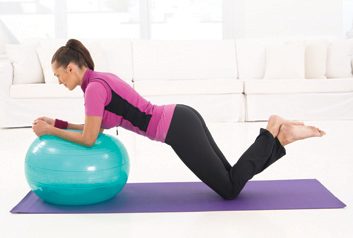
Roll out
Target: abs, back, hips.
Why it works : This exercise works the transverse muscles, the deepest part of the abdominal strap. They surround the abdomen acting as a natural sheath and stabilize the trunk; in the event of a fall, they allow better control of movements, limiting the risk of serious injury. The rollout also works the latissimus, large muscles that straighten the back, correcting and lengthening the silhouette, and flattening the stomach.
1. Kneeling in front of the ball, put the forearms on top, hands closed loosely, palms facing each other. Lift your feet up and cross your ankles. Lean forward slightly.
2. With your knees pivoting, lean forward and roll your forearms onto the ball, stretching the hips out and letting your chest drop. Stop the movement when your body forms a straight diagonal line from shoulders to knees.
Contract the abs, then return the ball to the starting position.4 /10
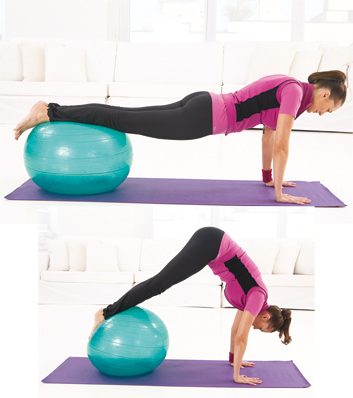
Carp
Target: abs, back, chest, shoulders, hips.
Why it works: this balancing movement requires good muscular control of the entire torso region and especially of the transverse abdominis.
1. Lie on the ball, face down, hands resting on the floor. Move your hands as if you were walking, so that the ball rolls to bring it under your shins, as in the starting position of the jack knife.
2. Keeping your legs straight, contract your abs, exhale, raise your hips and bring the ball as close to your hands as possible, without forcing. Hold the position for a second and then return to the starting position.
If the exercise is too difficult, put the ball under your thighs for the starting position, and decrease the range of
motion.5 /10
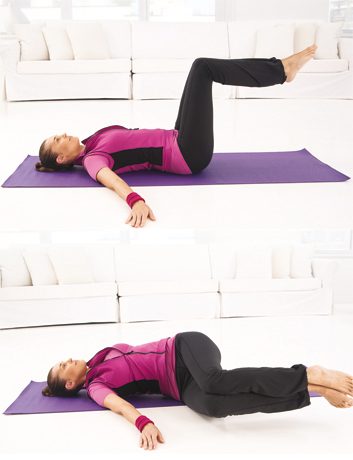
Pelvis rotation
Target: abs, obliques.
Why it works : You need to squeeze all the core muscles to stabilize it on the ground, and use your obliques to rock your legs to the side.
1. Lying on your back, raise your legs so that your thighs are perpendicular to the floor and bend your knees at a 90º angle. Without changing the angle of your hips and knees, swing your legs to the left while keeping your shoulders flat on the floor.
2. Return your legs to the starting position, then swing them to the right. These two movements constitute a single repetition. Do an uninterrupted set of 8 to 10 repetitions.6 /10
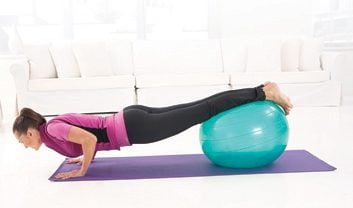
Pumps with balloon
Target: abs, chest, shoulders.
Why it works : Abs, obliques, and back muscles are put to full use simply because you need to stay stable and keep your body straight while performing this particularly demanding movement.
1. Adopt the starting position of the jack knife and pike.
2. Keeping your torso straight and abs tight, bend your elbows and lower your chest to the floor. Interrupt the movement when your arms are parallel to the floor. Take a break and return to the starting position.
The exercise will be easier if you place the ball under your thighs.7 /10
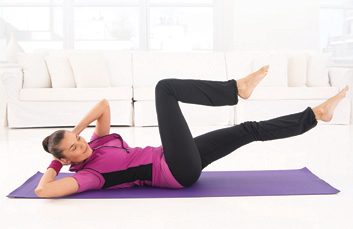
Crossed crunches
Target: abs, obliques.
Why it works: The abdominals act as a stabilization and power transfer system for the arms and legs. Researchers at San Diego State University ranked this exercise first for its effectiveness in working the abs.
1. Lie on your back with your hands behind your neck and your legs bent at a 90º angle.
2. Contract the abdominals and lift the shoulders and head off the ground; bring the right elbow into contact with the left knee as you extend your right leg to a 45º angle. Without returning to the starting position, bring the left elbow in contact with the right knee while extending your left leg at a 45º angle. These two movements constitute a single repetition. Do 8-10 in continuous series.
To make it easier for you, return to the starting position between repetitions.8 /10
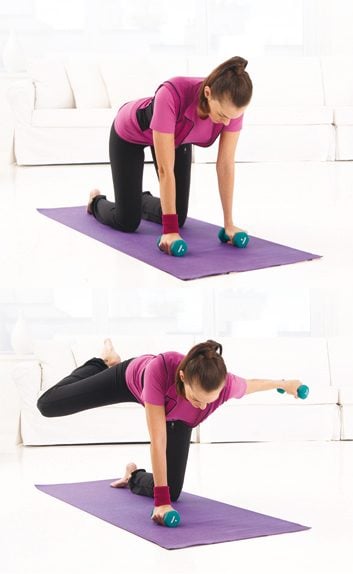
Spider
Target: upper back, shoulders, buttocks, torso.
Why it works : This movement strengthens the muscles that straighten your shoulders and keep you straight;
then it is easier to adopt the
perfect posture .
1. Get on all fours, back straight, hands in line with shoulders, and knees in line with hips.
2. Extend the left arm out to the side as you lift the right leg up, keeping it bent. Return to the starting position. Do the same with the right arm and the left leg.
To increase the degree of difficulty, do the exercise with light dumbbells.9 /10
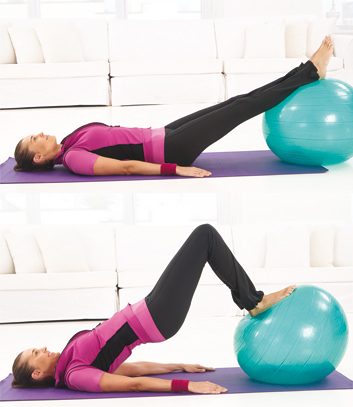
Bridge with balloon
Target: hamstrings, glutes, trunk.
Why it works: As we sit all day, our glutes and hamstrings (femoral biceps), which are supposed to keep us straight, contract and weaken. This exercise makes them work, improving posture and allowing them to move with ease.
1. Lie on your back and put your calves on the exercise ball. Extend your arms at your sides to provide support and stability. Raise your hips so that your body forms a straight line from shoulders to knees.
2. Without breaking the straight line, roll the ball towards your hips, bending the knees and bringing the heels towards you. Return to the starting position.10 /10
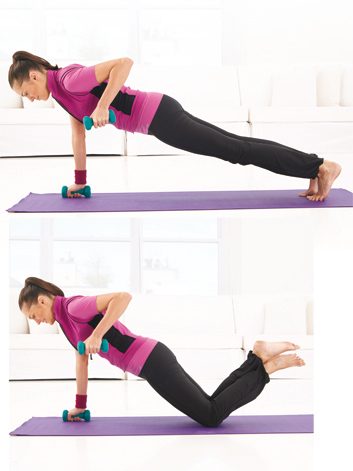
Plank and pull-up with dumbbell
Target : trunk, triceps, shoulders, rectus, biceps.
Why it works: We spend so much time with our backs hunched over that our shoulders end up rounding. This
exercise strengthens the core as well as the muscles that pull the shoulders back; you will be able to stand more upright, the chest well clear.
1. Position yourself as for push-ups, holding 2 to 5 kg dumbbells in your hands so that they are parallel to your body. Spread your feet a distance equal to that of your shoulders or hips (the further apart, the easier the exercise).
2. Keeping your back straight, lift your left arm and bring it back to your hip, while pushing down on the dumbbell with your right hand to ensure your balance. Return to the starting position and do the same with the right arm. Continue alternating reps to complete a set.
To facilitate the movement, do it on the knees, ankles crossed.